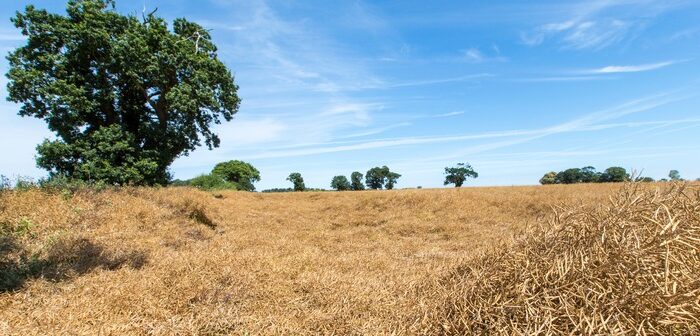Farmers managing oilseed rape with glyphosate before harvest can use the pod test to apply at the optimum timing.
There is usually variation in development and ripening of oilseed rape. Using glyphosate means the entire field ripens on the same timetable easing harvest planning and operations. But the correct timing is important according to Bayer Commercial technical manager Matt Siggs.
“First of all, don’t be too keen,” says Mr Siggs. “Applying too early could reduce yield and oil content plus increase the amount of red seed.” He recommends farmers using the pod test to check the crop.
“Aim to spray when senescence has begun so check the pods. Go right into the crop, not the headlands or tramlines to find a suitable place to sample. Look for an area of canopy which is representative of the field, this may be the main raceme or side branches depending on the crop.
“Choose 20 pods, if in 15 of these pods, at least two-thirds of the seed has changed from green to brown then it is safe to start spraying. If you are a bit below the threshold, come back in three days to check again.”
Target weeds too
Perennial weeds can also be targeted with the same application, glyphosate will be translocated to the rhizome helping to control weeds long-term. A higher rate of 1440g/ha is need for oilseed rape with perennial weeds, if there are only annual weeds 1080g/ha is sufficient. “Think about how the spray fits in with the weed control programme and the next crop. Fields going into wheat are likely to have a big gap until drilling so the additional weed control can keep stubbles cleaner for longer.”
Application guidance
The aim is for glyphosate to reach all the pods and any green material at the base of the crop; hence the application needs to penetrate through the entire canopy. A medium–coarse spray is a reliable option for canopy penetration. In thicker crops, higher water volumes of 200l/ha can improve coverage but always pay attention to the link between forward speed, nozzle choice and optimum pressure to ensure effective application.
“Time of day can also make a difference, there is typically higher humidity earlier in the day which means stomata are open increasing glyphosate uptake. Remember, glyphosate cannot enter the plant without a surfactant so an optimal loading of a quality adjuvant is essential. Increasing the dose will not make up for a poor, underloaded formulation.”
He points out that modern Bayer Roundup formulations have been developed to maximise uptake in a wide range of climatic conditions to give better, more consistent results. High temperatures and thundery downpours are two risks at this time of year which can be mitigated by better formulations.
Harvest interval
There is a statutory 14-day interval from spray until harvest, but the crop may need up to one week longer to fully ripen. Monitor the crop closely to decide when to start combining.




